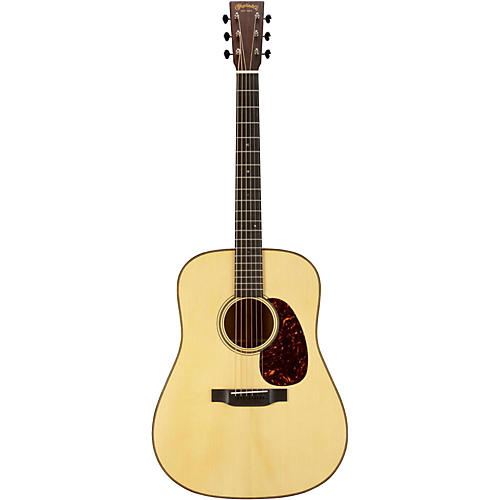Why Shop With Us?
Free Shipping
Free Standard Ground shipping (48 contiguous states, some overweight and Used/Vintage items excluded).
Orders placed before 3 p.m. ET usually ship the same business day.
Learn More2-Year Free Warranty on Guitars
Every guitar or bass you purchase from Musician's Friend (electric or acoustic, New or Open Box) includes two years of protection from manufacturer defects.
Contact Us for DetailsWe're Here for You
Our Gear Advisers are available to guide you through your entire shopping experience. Call or Chat for expert advice and to hear the latest deals.
Contact UsContact Us
Hablamos Español
866.226.2919
Hours:
MON - FRI 5 AM - 8 PM PT
SAT 6 AM - 6 PM PT
SUN 6 AM - 5 PM PT

Custom D-18 Sinker Mahogany Dreadnought Acoustic Guitar
false falseWe're sorry-this item is unavailable.
Contact our experts for a recommendation of great alternatives. Call us at 800-449-9128.
A bold model that responds to energetic playing without breaking up.
The following descriptions are from Sound Check Sessions that allow a small group of Martin employee/players to spend quality time with fresh instruments to discuss the concepts behind the creations, and to offer commentary on sound, feel, and look.
The Sinker Mahogany Dreadnought yielded these comments: œHave mercy! Now that' a mahogany dreadnought!
On the drawing board this guitar was approached as one that should not be underbuilt. The 5/16" scalloped bracing allows it to respond to energetic playing without breaking up. The consensus was that you can hammer the instrument with very favorable results. Great attack right off the pick. The instrument projected exceptionally- to the extent someone requested that the volume be turned down.
Bluegrass players who favor mahogany will appreciate the added density that the reclaimed sunken lumber brings to the recipe. The forward-shifted bracing opens up the bottom without losing its composure. Roots-rock and Americana players will find this long-scale dread to be immediately comfortable with a clean and lingering treble.
Why is sinker mahogany so special?
C.F. Martin Co. was fortunate to acquire a very special mahogany discovered in Belize “ unique in both age and character. What began as a product of British Colonialism and Empire expansion approximately 300 years ago is now seeing the light of day in special instruments crafted by C.F.Martin & Co. British expansion across the globe opened opportunities to obtain the raw materials required to fuel growth in England and elsewhere throughout the empire. Wood “ lots of it- is the material that made growth and exploration possible.
English exploration into Central America uncovered a treasure of mahogany perfect for the construction of the ships required to maintain military and economic dominance. Mahogany was also perfect for other architectural or utilitarian purposes. Harvests of old-growth mahogany were floated down streams for processing near the point of export. As the naturally dense mahogany was being floated, the oldest, heaviest, and most dense logs would settle among the bottom of the floating mass. Some would become trapped by obstructions, while other logs would take on enough water to ultimately lose their buoyancy and drop to the bottom of the river. Once trapped underwater “ often at great depths “ the bark would be worn away allowing the log to become somewhat œpreserved by a relentless barrage of river silt, algae, and lack of oxygen. As a naturally spongy material, the wood absorbs mineral from the murky environment. This mahogany was approximately 250-300 years old at the time of first harvest.
Fast-forward 300 years. Rivers change course over time creating slow moving bends or œox-bow lakes. Locals know that wood may be found in the still water that' now accessible, and re-harvesting from these areas is an important part of the economy in these regions. Logs located in these areas are lassoed and winched to the surface. It' a dangerous and time consuming process just to bring the logs up after being mired underwater for centuries.
Once re-harvested, the call goes out to a small community of exotic wood specialists around the world. Competition for this material is fierce and diverse. The automotive industry, luxury aircraft and yacht companies, specialist furniture manufacturers, and countless producers of high-end consumer goods all struggle to find premium woods for their unique products. An acoustic instrument manufacturer is a small player against these high-volume exotic wood consumers. Martin was fortunate to have acquired this special mahogany facing such competition and considering their relatively small scale in the exotic wood-using world. Their specialists were among the first on the ground to physically inspect the un-processed material in-country. After evaluation, the log was harvested onsite.
Processing this sinker mahogany for a premium Martin acoustic instrument requires more time and effort than other materials. The aging and dramatic mineralization experienced by the wood makes it denser and consequently more destructive to the processing equipment. In fact, freshly processed sinker mahogany acquires a smooth glossy sheen during cutting caused by the dust actually self-sanding the surfaces against the cutting blade. Not only do the blades have to be replaced more often, but the wood must actually be roughed up to improve adhesion for construction.
Harvest and export of this old-growth mahogany in Belize was ceased by the British prior to the arrival of C.F. Martin in New York. It was their assessment that this material pre-dates similar woods that would have been available circa 1833. In combined age, it is believed this sinker mahogany to be some 500-600 years old.
Processed sinker mahogany retains the visual shimmer and flecking created by the mineral absorption and subsequent processing. The grain also exhibits unique variety across the surface primarily due to the significant age of the wood before original harvest. Remember, this material was 300+ years old when it was first harvested.
Sonically, the mineral absorption creates a physically heavier material. All things equal, a denser material has potential to transmit enhanced bass spectrum frequencies- clean, articulate, and low. It' the best of the character that mahogany is known for. Sound is subjective, and the experiences of two listeners will always differ. Therefore, it' inaccurate to state that sinker mahogany is œmore of any single quality over another. Rather, Martin believes it' the œbest of the inherent qualities attributed to mahogany throughout its generations of use in acoustic instruments.
Sinker mahogany is among the most unique materials they™ve been able to acquire throughout almost 200 years of continuous manufacturing. Its age and extreme state of preservation make the instruments exclusive among all others. The marriage of sinker mahogany with proven C.F. Martin construction techniques allow the owner to experience a rarity of materials and a purity of sound ... for a lifetime of enjoyment.
PRG inventory changes regularly, so please contact your Guitar Advisors at 866-926-1923 for the latest availability and an in-hand description of the instruments.
Features
- Body size: D-14 fret
- Top: Adirondack spruce
- Back and sides: Sinker mahogany
- Top and back binding: Madagascar rosewood
- Neck: Select hardwood
- Neck shape: Modified V
- Fingerboard: Ebony
- Nut: Bone, 1.75"
- Fingerboard radius: 16"
- Frets: 20
- Scale length: 25.4"
- Tuners: Gotoh
- Bridge: Ebony
- Saddle: Compensated bone
- Finish: Gloss/satin neck
- Case: Hardshell
This might be the guitar you've been waiting for. Call Private Reserve Guitars today.
- Free Standard Ground shipping (48 contiguous states, some overweight and Used/Vintage items excluded).
- Orders placed before 3 p.m. ET usually ship the same business day.
Every guitar or bass you purchase from Musician's Friend (electric or acoustic, New or Open Box) includes two years of protection from manufacturer defects.
Our Gear Advisers are available to guide you through your entire shopping experience. Call or Chat for expert advice and to hear the latest deals.

Musician's Friend Support





































































































































